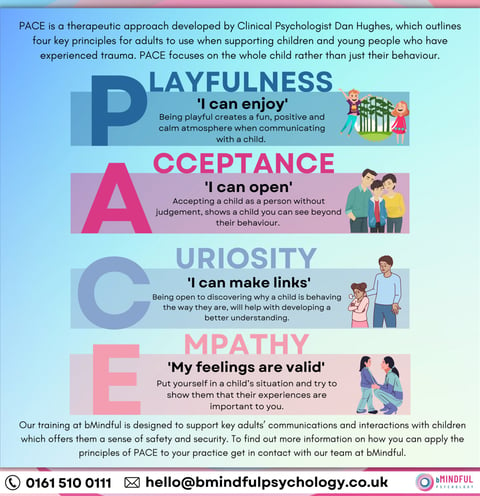Principles of PACE
Playfulness
A light-hearted, relaxed and playful attitude. Helps the child feel connected within their relationship. Helps the child experience fun and love.
Acceptance
Accepting the child for who they are and not what they achieve is very important. It is important to make the child aware that it is their behaviour that is unacceptable not them as a person. The child needs to feel liked and accepted for who they really are.
Curiosity
Figuring out what is going on. Understand the meaning behind the behaviour.
Wonder about the child.
Wondering with the child.
Make best guesses about the inner experience of the child.
Empathy
One of the most important aspects of the PACE approach.
To understand a child’s needs you have to be able to “step into their shoes”.
Empathy allows an individual to feel their feelings and know that their feelings have been heard and are valid. You may not agree with their feelings and opinions, which is ok but by listening you are supporting them to not suppress their feelings, which is crucial to positive mental health.
Think about your relationships in your own life. Do you open up to people who are harsh and do not listen to you? Or people who listen, are accepting of you, and value you as a person?
Top Tips for Empathy by Dr Johanna Hilton
Empathy is a skill to develop with practice.
Say something that guesses at how the child is feeling.
Use cautious language – “I wonder if / you might be / it seems” rather than “you must be / I bet you are”.
Match your voice tone to their feeling.
Avoid direct questions – don’t ask “are you feeling angry?”.
Talk about their feelings, not yours or another’s – don’t say “imagine how your mum / sibling / peer will feel”.
Try to stress the here and now of their distress – use “today”, “right now”, “at the moment”.
Remember, avoid the temptation to add a BUT!
PACE
The PACE parenting model was created by Dan Hughes, a clinical psychologist specialising in the treatment of children who have experienced abuse and neglect.
PACE is a way of thinking, feeling, communicating, and behaving that helps a child feel safe.
It helps to promote secure attachments and enables a child to reflect on their thoughts and behaviours without being judged.


What is PACE?
